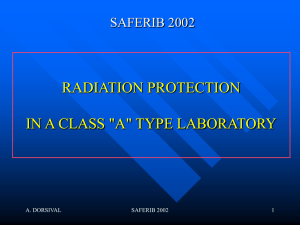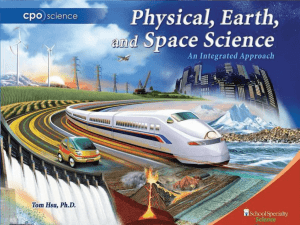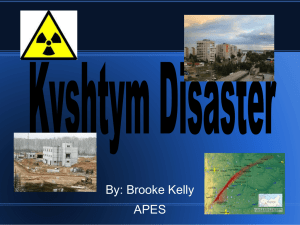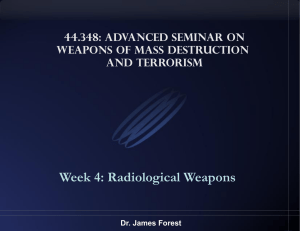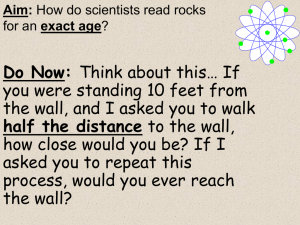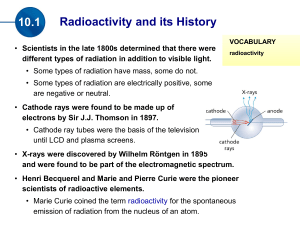Strategies for Radioactive Decontamination of Livestock
advertisement
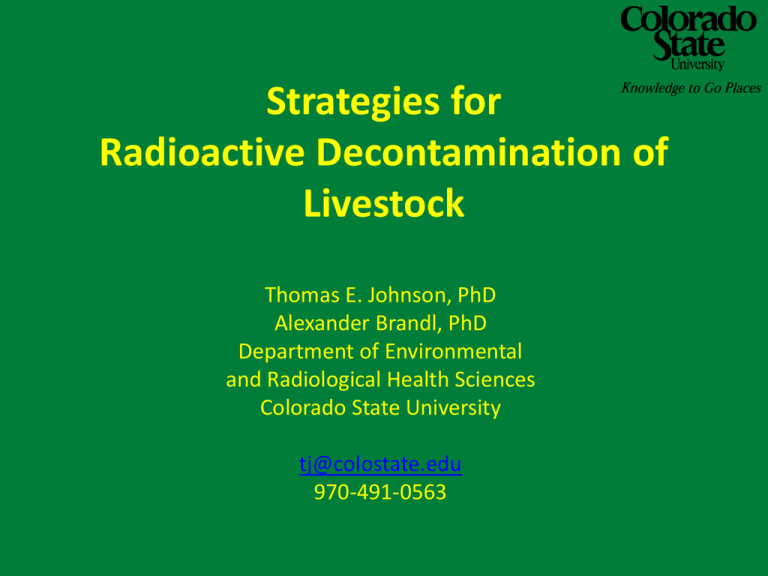
Strategies for Radioactive Decontamination of Livestock Thomas E. Johnson, PhD Alexander Brandl, PhD Department of Environmental and Radiological Health Sciences Colorado State University tj@colostate.edu 970-491-0563 Overview • Goal: Removal of radioactive materials from surfaces of livestock— possibly from a dirty bomb, nuclear weapon or reactor accident Definitions • • • • • • • • • Background radiation Source Term Contamination/Radiation Radioactive Contamination: External Internal Contamination Fugitive dusts and re-suspension Plume Noble Gases Fallout/Fission products Background Radiation • Radiation from the sun, cosmic rays, rocks, soil, plants, water • Usually naturally occurring – Bulk is from the sun or when the earth was formed • Almost ALL radiation detection instruments will read above zero when no “radioactive material” is present • Demonstration Definitions • Source term: Quantity of radioactive materials that are available to be dispersed • Radiation: emission of particles or energy from an atom that may cause damage to the body • Contamination: unwanted radioactive material in an unwanted place. Usually particles Definitions (2) • Radioactive contamination: External – Radioactive particles or other radioactive materials that adhere to the outside of a body and are NOT incorporated into the tissues • Internal Contamination: – Radioactive materials that are taken into the body. – Some radioactive materials may be incorporated into the body tissues – Some radioactive materials may just “pass through” Definitions (3) • Fugitive Dusts and re-suspension – Radioactive particles that are on the ground or in the air and are spread by wind. – Those that settle and are picked up by the wind again to re-spread. • Plume: a generally large “cloud” of radioactive particles that spread over an area, and the resulting settling of radioactive particles on the ground. Definitions (4) • Noble Gases: In this context, the radioactive gases that are found in reactors and as a product of nuclear weapons. They do not react with anything and do not form particles. – Generally short lived (minutes) – Only a hazard if you are in them! – Generally only a hazard to skin • Fallout: Radioactive particles that fall from the sky, generally associated only with weapons Definitions (5) • Fission Products: the radioactive materials resulting from reactors or weapons – Generally a wide range of radioactive materials – MOST are short (minutes) lived • Radioactive decay/half life: time for half of the material to disintegrate. Radiation Dose • Deposition of energy from radioactive materials in living tissue • Many units, some not scientifically correct, but used anyway • Lethal human dose if delivered in a short time (in various units) to the whole body – 400 rems: 400 rads: 400 roentgens (R) – 4 Sieverts (Sv): 4 Gray (Gy) – How many “clicks” on a GM would this be? Types of Radiation Events • Radioactive Dispersal Devices – “Dirty Bombs” • Reactor Accident • Nuclear Weapons Radioactive Dispersal Devices (RDD) • Any method used to deliberately disperse radioactive material to create terror or harm. A dirty bomb is an example of an RDD. – It is made by packaging explosives (like dynamite) with radioactive material to be dispersed when the bomb goes off. • GENERALLY – No fatal doses of radiation – Only covers “small area” Reactor Accident • Accidental release of radioactive materials from a Nuclear Reactor – Chernobyl – Fukushima – Three Mile Island • Generally a Dispersal of volatile materials – over a period of time – over a wide area – Lots of time to panic Nuclear Weapons • Detonation of a uranium or plutonium based weapon that yields fission products – Hiroshima, Nagasaki • Large amounts of multiple types of radioactive materials – Large area involved – Transported by atmosphere over entire hemisphere if surface/air burst Distances from Source Term to Significant Contamination • RDD – Not expected to travel far – meters not miles • Reactor – May travel meters to miles from source; Generally lower concentrations at distance – Snow, rain will impact • Weapon – impact from meters to miles What to do if: (precautions) • Know in advance of radioactive plume • It is currently happening • Plume has passed Evacuation • May or may not be the best action – Shelter in place for noble gases – If radioactive contamination expected to be low, may not be important • Example: Three Mile Island – Food, water, shelter for animals may be a problem – May be very costly • Always move cross wind or upwind of source term (release point) Shelter • If radioactive particulate anticipated to fall on livestock – Move animals under shelter • ANYTHING is better than nothing – Use feed that has been kept under cover • Tarps may be sufficient for most feed (hay) • If not covered, only upper layers may have radioactive contamination, lower layers may still be usable • You may be able to see the radioactive contamination, depending on the event – Use water that has been under cover Shelter (2) • Keep animals under shelter until plume (cloud of radioactive contaminants) has passed. – Remember re-suspension is still possible • Try to move animals into facilities or pasture that is not contaminated (upwind) • Note that if sheltering in place you should stop unfiltered ventilation – Any filtering will help – Filters will be filled with radioactive contaminates when plume has passed No Shelter, No Evacuation • Still possible that animals did not get contaminated as plumes tend to be unpredictable • External contamination levels may be low – If so, move animals to uncontaminated area and uncontaminated feed – Over time, radioactive materials eaten will be removed by natural processes – May require extensive monitoring External Contamination • Unlikely that animals will “drop dead” due to radiation, regardless of the event • Best course may be to leave animals in contaminated pasture where they were when event occured • Limited information on what is effective at removing external contamination – Current subject of research at CSU – May take large volumes of water – Runoff is contaminated External Decontamination • Anti-contamination clothing will cause animal stress – Person in “street clothes” to help keep calm • Small amounts probably not a concern – Brush/vacuum off – How much is small? – May be best to provide clean feed until no internal contamination • Not as easy to detect! – May be able to delay Internal Contamination • Animals eating radioactive contamination – Radioactive particles fall onto plants and water and are consumed • Feed animals uncontaminated food and water – Radioactive contaminants become incorporated into the tissues – May take up to three months to remove, or longer – Must be kept in “uncontaminated” areas – Droppings will be contaminated Perception Problems • “Snowball” • Euthanizing animals may produce a bigger problem – Disposal of bio-rad-waste is expensive – May not be necessary • Difficulty in finding slaughterhouse to take decontaminated animals – Difficulty in selling decontaminated animals • Consider alternative uses/markets Fear and Panic • • • • Few people understand radiation Most are afraid, even if decontaminated Find experts to assist Unlikely that radioactive contamination will cause immediate injury to animals (or humans) • CSU faculty and staff are available to help! • • • • • • • • • • • • References http://www.euranos.fzk.de/index.php?action=euranos&title=products http://www-naweb.iaea.org/nafa/news/radioactive-contamination.html http://www.iaea.org/nafa/dx/emergency/agricultural/index.html Guidelines for Agricultural Countermeasures Following an Accidental Release of Radionuclides, IAEA Technical Reports Series No. 363,1994. Planning Guidance for Response to a Nuclear Detonation, Homeland Security Council, Second Edition, June 2010: http://hps.org/hsc/documents/Planning_Guidance_for_Response_to_a_Nuclear_Detonation2nd_Edition_FINAL.pdf C. D. Berger, J. R. Frazier, R. T. Greene, B. R. Thomas, J. A. Auxier, Radiological Emergency Manual for Livestock, Poultry, and Animal Products, IT Corporation/ Radiological Sciences Laboratory, Oak Ridge, Tennessee 37831, Report Number IT RSL 87 168, December 1987 Survival of Food Crops and Livestock in the Event of Nuclear War, D.W. Bensen, A.H. Sparrow, US. Atomic Energy Commission, December 1971 USDA Radiological Monitoring Handbook, Agricultural Research Service, Agriculture Handbook No. 246, 1963. B.J. Howard, N.A. Beresford, G. Voigt, Countermeasures for Animal Products: a Review of Effectiveness and Potential Usefulness after an Accident, Journal of Environmental Radioactivity 56, 115–137, 2001 R.M. Alexakhin, Countermeasures in Agricultural Production as an Effective Means of Mitigating the Radiological Consequences of the Chernobyl Accident, Sci. Total Environ. 137, 9–20, 1993 Handbook of Radioactive Contamination and Decontamination J. Severa, J. Bár, Elsevier Science; 1st edition, December 1, 1991 USDA Radiological Monitoring Handbook, Agricultural Research Service, Agriculture Handbook No. 246, 1963.

